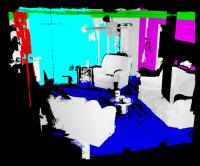May 11 2010
Researchers from University of Missouri have devised a new software that could prove useful during emergencies. The software has been developed for a remote-controlled robot that incorporates a laser sensor.
The robot is designed to enter dangerous buildings to examine the stability of buildings and to detect potential survivors. This novel technique may allow rescue operators to execute their work safely and efficiently.
 Colorful 3-D map of the interior of a building
Colorful 3-D map of the interior of a building
According to MU College of Engineering’s Associate Professor of Computer Science, Ye Duan, the graphics visualization software will enable users to view and analyze the three-dimensional data scanned by the robot. This data helps the rescuers to determine the building structure before entering the premises.
The robot is specifically designed to carry a Light Detection and Ranging (LIDAR) unit. It captures multiple scans by utilizing LIDAR, which has the capacity to take 500,000 point measurements in one second. After the scanning process, the software transforms the data points into a unique three-dimensional map that creates floor plans and depicts individual objects in different colors. The software can take half-an-hour to two hours to create a 3D map depending upon the size of the data available. The robot is also designed to scan through windows and walls.
Duan further informed that the software can be used for a number of applications apart from emergencies. For instance, it can be utilized to examine buildings and structures routinely, which can help in preventing disasters. It can also aid the military in reducing wartime casualties. The current robot model is large and researchers are planning to make it smaller.
The research article has appeared in International Journal of CAD/CAM. The robot features among the list of Kiplinger's "8 Robots That Will Change Your Life." Professor Duan, MU students, and Missouri S&T associate professor and students collaborated to develop the software.